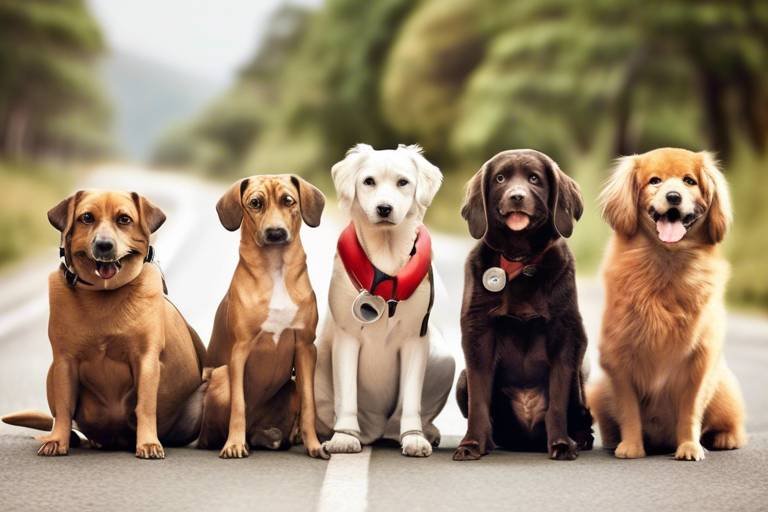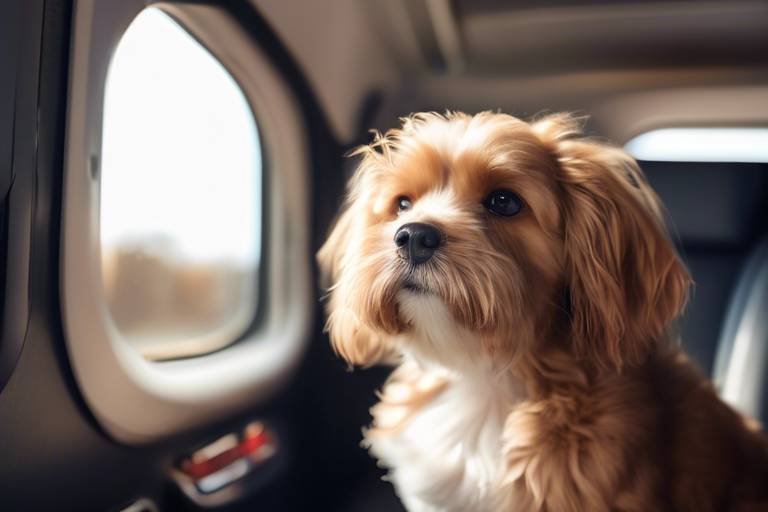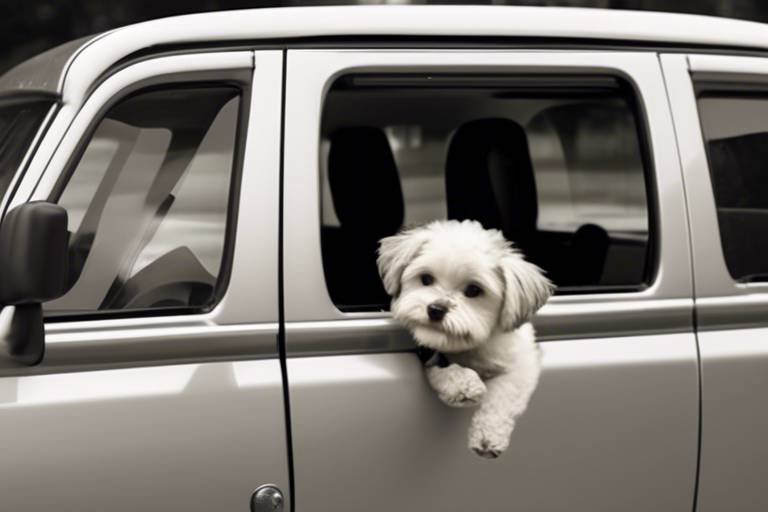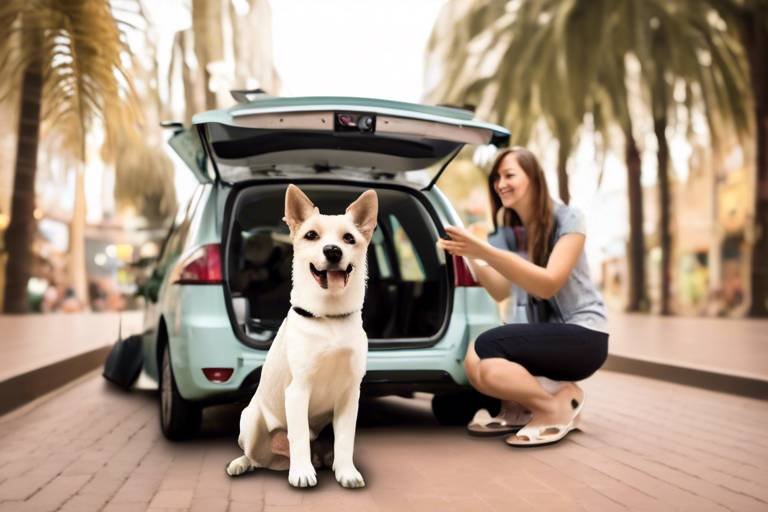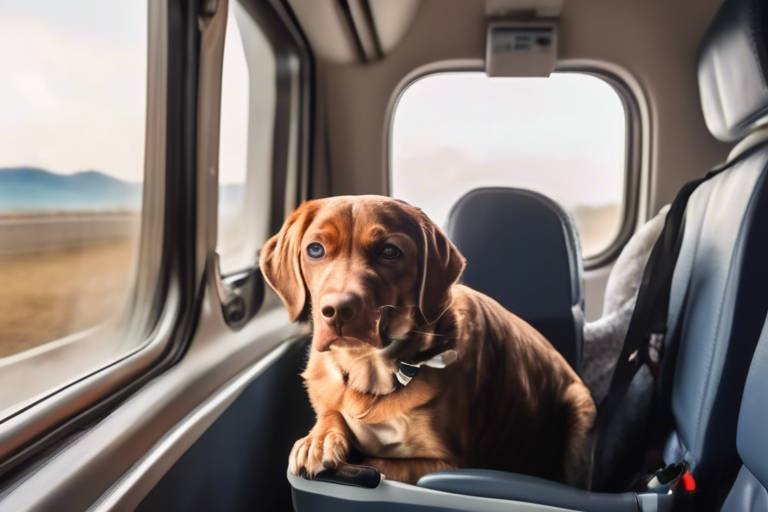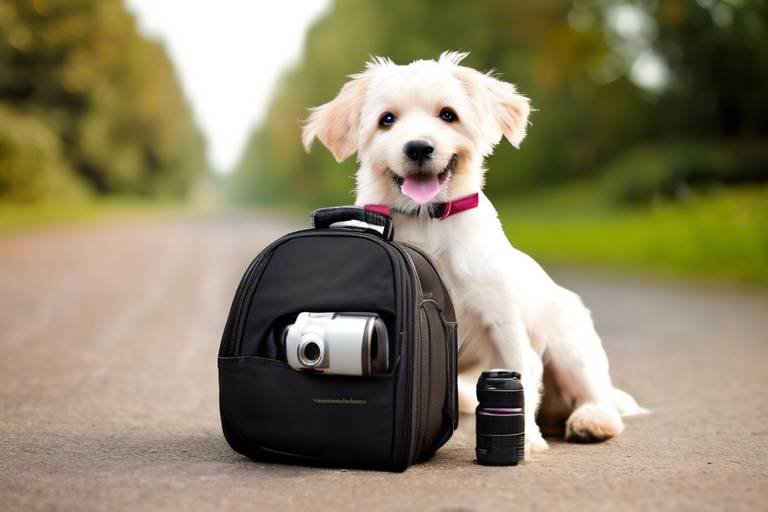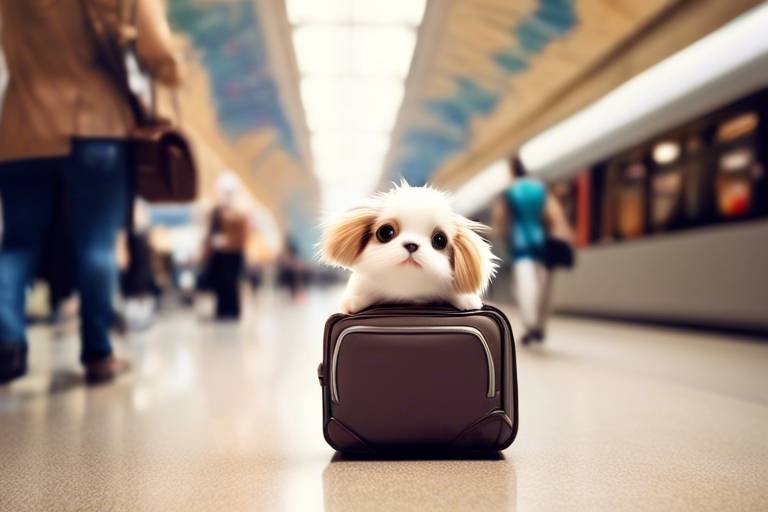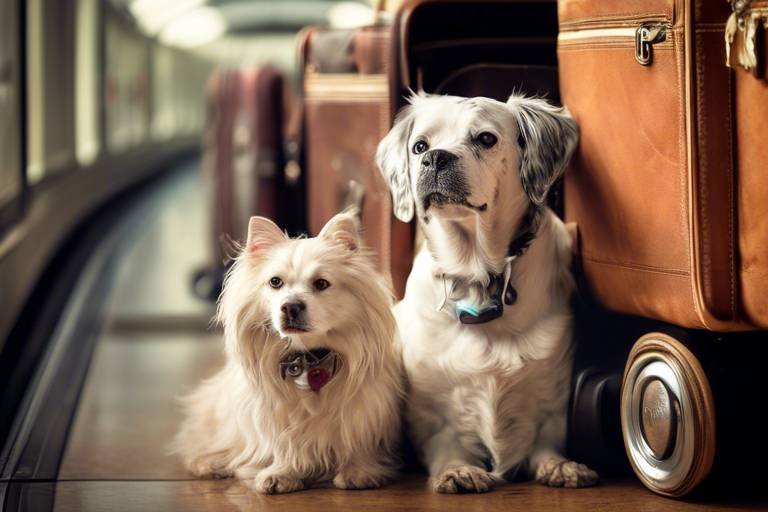Tips for Traveling with Pets in Groups
Traveling with pets can be a delightful adventure, but when you add a group into the mix, things can get a little tricky. Imagine a lively road trip filled with wagging tails, excited barks, and the occasional meow—sounds fun, right? However, without the right planning, this fun can quickly turn into chaos. So, whether you're hitting the road with friends or family, here are some essential tips to ensure a smooth and enjoyable experience for both pets and their owners.
Effective planning is crucial when traveling with pets in groups. Before you even think about packing your bags, take some time to consider accommodations, transportation, and pet-friendly destinations. It’s all about making sure everyone’s needs are met. Think of it like organizing a potluck dinner; you want to ensure that everyone brings something to the table, including your furry friends. Start by creating a checklist of what you need to consider:
- Accommodations: Research places that are welcoming to pets.
- Transportation: Decide on the best way to travel with your group.
- Activities: Look for pet-friendly attractions that everyone can enjoy.
Selecting the right place to stay is vital for a successful trip. Imagine arriving at a hotel only to find out that your beloved pet is not allowed. That’s a mood killer! To avoid this, research hotels, rentals, or campsites that specifically welcome pets. Websites like BringFido or Airbnb can be great resources. Additionally, understanding their policies is key to avoiding any surprises during your trip.
Different accommodations have varying pet policies. Some might charge extra fees, while others may have restrictions on the number of pets allowed. Always check these details before booking to keep your pets comfortable and safe during your stay. For example, you might find a charming cabin that allows two pets, but if you’re traveling with four, you’ll need to make alternate arrangements. Transparency is essential!
It's not just about the number of pets; some places may have limitations on the size or breed of pets allowed. If you have a Great Dane, you might run into issues at a place that only accommodates small breeds. Check these details in advance to avoid complications upon arrival. A quick phone call to the accommodation can save you from a stressful situation later.
Look for accommodations that offer pet-friendly amenities, such as dog parks, pet beds, or walking areas. These little extras can enhance the overall experience for your furry companions and make your trip much more enjoyable. After all, a happy pet means a happy owner! Imagine your pup frolicking in a dog park after a long day of travel—it’s the perfect way to unwind.
Choosing the right mode of transportation is essential for group travel with pets. Evaluate options like cars, buses, or planes based on comfort and convenience for your pets. If you're driving, make sure your vehicle can comfortably accommodate everyone. If flying, check with the airline for their pet policies, as they can vary widely. Remember, the journey is just as important as the destination!
Ensuring the safety of pets during travel is paramount. Implement strategies to keep them secure and comfortable while on the move. This not only reduces stress for everyone involved but also ensures a smoother journey. Think of your car as a mini mobile home for your pets—safety should always come first!
Utilizing harnesses, crates, or seat belts for pets can prevent distractions and injuries while driving. Always prioritize safety to ensure a smooth trip. It’s like wearing a seatbelt; it’s a simple step that can make a huge difference in case of an unexpected stop.
Regular stops are essential for pets to stretch, relieve themselves, and hydrate. Plan your route to include pet-friendly rest areas for a more enjoyable journey. Think of it as a road trip pit stop—everyone needs a break now and then! Keep a portable water bowl handy to keep your pets hydrated during these breaks.
Engaging your pets in fun activities during the trip is important for their well-being. Explore pet-friendly attractions and recreational options to keep them entertained. After all, a bored pet can lead to mischief!
Visiting local parks allows pets to socialize and exercise. Research nearby parks to find suitable areas where your pets can enjoy the outdoors safely. Imagine your dog chasing a frisbee while you relax in the sun—pure bliss!
Many destinations offer attractions that cater to pets. Look for pet-friendly restaurants, beaches, or events to create memorable experiences for your furry friends. It’s like finding a hidden gem; these spots can turn an ordinary trip into an extraordinary adventure!
Q: How do I find pet-friendly accommodations?
A: Use websites like BringFido or Airbnb, and always read reviews to ensure the place truly welcomes pets.
Q: Can I take my pet on public transport?
A: It depends on the transport service. Always check their pet policy beforehand.
Q: What should I pack for my pet?
A: Bring food, water, bowls, leash, waste bags, bedding, and any medications your pet may need.

Planning Ahead for Group Travel
When it comes to traveling with pets in groups, effective planning is absolutely crucial. Imagine the chaos of arriving at your destination only to find that your accommodations don’t allow pets or that the transportation options are less than ideal. To avoid such scenarios, it’s essential to consider several factors well in advance. First, think about your accommodations. Are you going to stay in a hotel, a rental, or perhaps a campsite? Each option comes with its own set of pet policies and amenities, so doing your homework ahead of time can save you from unexpected surprises.
Next, transportation is another key element that requires careful thought. Depending on the number of pets and people in your group, you might need to evaluate different modes of travel—be it by car, bus, or plane. While a car might offer the most flexibility, you should also consider factors like comfort and convenience for your furry friends. For example, if you're traveling by plane, check the airline's pet policies, as they can vary significantly. You wouldn't want to find out last minute that your pet can't travel in the cabin with you!
Additionally, you should think about the destinations you plan to visit. Are they pet-friendly? Researching parks, beaches, and other attractions that welcome pets will ensure that everyone in your group, including your four-legged companions, has a great time. You might even discover hidden gems that are perfect for your pets to explore and enjoy.
To make your planning even smoother, consider creating a checklist of all the necessary arrangements. Here’s a simple table to help you visualize what you need to cover:
| Planning Aspect | Details |
|---|---|
| Accommodations | Research pet-friendly hotels, rentals, or campsites. |
| Transportation | Evaluate options based on comfort and convenience for pets. |
| Activities | Find pet-friendly parks, beaches, and attractions. |
By taking the time to plan ahead, you can ensure a smooth and enjoyable experience for both your pets and your travel companions. Remember, a little foresight can go a long way in making your group trip a memorable adventure!

Choosing Pet-Friendly Accommodations
When it comes to traveling with your furry companions, choosing the right accommodations is of utmost importance. Imagine arriving at your destination only to find out that your hotel doesn’t allow pets or has a hefty fee that you weren't prepared for. To avoid any unpleasant surprises, it’s crucial to do your homework before you hit the road. Start by researching various lodging options that explicitly welcome pets. This can range from hotels and motels to vacation rentals and campgrounds. Each of these options has its own set of rules and amenities, so understanding them is key to ensuring a smooth trip.
One of the first steps in your search should include checking out online platforms that specialize in pet-friendly accommodations. Websites like BringFido or PetsWelcome can be invaluable resources. They not only list pet-friendly places but also provide reviews from fellow pet owners, giving you a clearer picture of what to expect. While browsing, pay close attention to the details of their pet policies. This includes any additional fees, weight restrictions, or breed limitations that may apply.
To help you navigate this process better, here’s a quick overview of what to keep in mind:
| Accommodation Type | Pros | Cons |
|---|---|---|
| Hotels | Convenient, often have pet amenities | May charge extra fees |
| Vacation Rentals | More space, home-like environment | Less immediate support |
| Campsites | Great for adventure, usually pet-friendly | Limited facilities |
Another important aspect to consider is the size and breed restrictions that some accommodations enforce. For instance, if you have a large breed dog, it’s essential to verify whether the place you’re considering has any limitations. Some hotels might only allow small dogs, while others may have specific breed restrictions due to insurance policies. Always check these details in advance to avoid any last-minute complications upon arrival.
Additionally, look for accommodations that offer pet-friendly amenities. These can significantly enhance your stay and make it more enjoyable for your furry friend. Features like dog parks, pet beds, or designated walking areas can make a world of difference. It's like staying at a place that truly understands your pet's needs, allowing you to relax and enjoy your vacation without worrying about their comfort.
In conclusion, taking the time to choose the right pet-friendly accommodations will set the tone for a fantastic trip. By planning ahead and being aware of the policies and amenities, you can ensure that both you and your pets will have a delightful experience. Remember, happy pets lead to happy travels!
- What should I look for in pet-friendly accommodations? Look for places that specifically mention pet policies, size and breed restrictions, and available amenities for pets.
- Are there extra fees for bringing my pet? Many accommodations do charge additional fees for pets, so it’s essential to check this beforehand.
- Can I find pet-friendly accommodations in every city? While many cities do offer pet-friendly options, availability can vary, so it’s best to research in advance.
Understanding Pet Policies
When planning a group trip with your beloved pets, one of the most crucial aspects to consider is the pet policies of your chosen accommodations. Each hotel, rental, or campsite may have its own set of rules, and understanding these can save you from potential headaches later. Imagine arriving at your destination only to find out that your furry friend isn't welcome or that there are unexpected fees you weren't prepared for. To avoid such situations, it’s essential to do your homework ahead of time.
First and foremost, check for any pet fees associated with your stay. Many places charge a non-refundable cleaning fee or a nightly rate for pets. Knowing these costs in advance allows you to budget accordingly. Additionally, inquire about any weight limits or breed restrictions that may apply. For instance, some accommodations might only accept pets under a certain weight or may have a list of breeds that are prohibited due to insurance policies. Being informed about these restrictions can save you from the disappointment of being turned away at check-in.
Moreover, it's wise to look into the specific requirements that your accommodation may have. Some places might ask for proof of vaccinations or require your pet to be crated when you’re not in the room. Familiarizing yourself with these rules ensures that your pet remains comfortable and safe throughout your stay. If you have any questions or need clarification, don’t hesitate to reach out to the property management before your trip; they’ll appreciate your diligence and can provide you with the most accurate information.
Lastly, consider the additional amenities that each accommodation offers for pets. Some hotels provide dog parks, pet beds, or even grooming services. These little extras can significantly enhance your pet's experience and make your trip more enjoyable. Imagine your dog having a blast at a designated play area while you relax nearby! To help you visualize this better, here’s a simple table comparing the amenities offered by different types of accommodations:
| Accommodation Type | Pet Fees | Weight Limit | Pet Amenities |
|---|---|---|---|
| Hotel | $50 one-time fee | Up to 50 lbs | Dog park, pet beds |
| Rental | $100 cleaning fee | No limit | Fully fenced yard, pet-friendly kitchen |
| Campsite | No fee | Up to 70 lbs | Dog-friendly trails, pet washing station |
By understanding the pet policies of your accommodations, you can ensure a smoother, more enjoyable experience for both you and your pets. Remember, a little preparation goes a long way in making your group travel adventure a memorable one!
- What should I do if my pet is not allowed at my accommodation?
If your pet is not allowed, consider finding a nearby pet-friendly hotel or look into pet-sitting services. - Are there any extra costs associated with bringing my pet?
Yes, many places charge pet fees or deposits, so it’s essential to check beforehand. - Can I leave my pet alone in the room?
It depends on the accommodation's policy; some may require pets to be crated or may not allow them to be left unattended.
Size and Breed Restrictions
When embarking on a group trip with your furry companions, one of the key aspects to consider is the that various accommodations may impose. It's not just about whether your pet can come along; it's about ensuring that the place you choose is truly welcoming to all types of pets. Imagine arriving at a beautiful pet-friendly hotel only to find out that your beloved Great Dane isn’t allowed because of weight restrictions. Such surprises can lead to unnecessary stress for both you and your pet!
To avoid any last-minute hiccups, it's crucial to do your homework beforehand. Different accommodations have different policies regarding size and breed. Some may allow only small breeds, while others might have no restrictions at all. Here are a few important points to keep in mind:
- Research Thoroughly: Before you book, check the specific size and breed policies of each accommodation. Websites often provide detailed information, but a quick phone call can clarify any uncertainties.
- Consider the Environment: Larger breeds may require more space and exercise, so look for places that offer ample outdoor areas or pet parks nearby.
- Check for Additional Fees: Some places charge extra fees for larger pets or specific breeds, so factor this into your budget.
Furthermore, it’s also wise to be aware of any breed-specific legislation in the area you’re visiting. Certain places might have restrictions on breeds that are considered aggressive, which can include popular breeds like Pit Bulls or Rottweilers. Knowing these regulations not only helps you avoid fines but also ensures the safety of your pet and others.
In summary, paying close attention to size and breed restrictions can significantly enhance your travel experience. It allows you to plan better, ensuring that your furry friends can join in on the fun without any unexpected challenges. Remember, the goal is to create wonderful memories together, and a little preparation goes a long way in making that happen!
Q: What should I do if my pet's breed is restricted at an accommodation?
A: If your pet's breed is restricted, consider looking for alternative accommodations that are more inclusive. Many pet-friendly places are open to all breeds, so a bit of research can go a long way.
Q: Are there any specific breeds that are commonly restricted?
A: Yes, breeds such as Pit Bulls, Rottweilers, Doberman Pinschers, and certain mastiffs are often restricted due to insurance policies or local laws. Always check the specific rules of the place you plan to stay.
Q: How can I find pet-friendly accommodations that don’t have size restrictions?
A: Websites dedicated to pet-friendly travel, such as BringFido or PetFriendly, allow you to filter accommodations by size and breed restrictions, making it easier to find the perfect spot for your group.
Additional Amenities
This article provides essential tips for traveling with pets in groups, ensuring a smooth and enjoyable experience for both pets and their owners. Discover best practices for planning, safety, and fun activities.
Effective planning is crucial when traveling with pets in groups. Considerations include accommodations, transportation, and pet-friendly destinations to ensure everyone’s needs are met.
Selecting the right place to stay is vital. Research hotels, rentals, or campsites that welcome pets, and understand their policies to avoid any surprises during your trip.
Different accommodations have varying pet policies. Ensure you are aware of any fees, restrictions, or requirements to keep your pets comfortable and safe during your stay.
Some places may have limitations on the size or breed of pets allowed. Check these details in advance to avoid complications upon arrival.
When traveling with pets, it's not just about finding a place to sleep; it's about ensuring that both you and your furry friends have a comfortable experience. Look for accommodations that offer tailored for pets. These can significantly enhance your stay and make your pet feel more at home.
For instance, some hotels provide dog parks or designated walking areas where your pets can stretch their legs and socialize with other animals. Imagine your pup bounding around with joy in a spacious yard, tail wagging furiously! Other properties might offer pet beds or bowls, so you don't have to pack extra supplies, making your travel lighter and more convenient.
Additionally, consider accommodations that have grooming services or pet-sitting options. These services can be a lifesaver if you plan to explore places where pets aren’t allowed. You can enjoy your outing knowing that your pet is well cared for. Moreover, some places even have pet-friendly dining areas, allowing you to enjoy a meal without leaving your furry companion behind.
In summary, when choosing a place to stay, look for amenities that cater to your pet’s needs. This not only ensures their comfort but also enhances your overall travel experience. Remember, a happy pet makes for a happy trip!
Choosing the right mode of transportation is essential for group travel with pets. Evaluate options like cars, buses, or planes based on comfort and convenience for your pets.
Ensuring the safety of pets during travel is paramount. Implement strategies to keep them secure and comfortable while on the move, reducing stress for everyone involved.
Utilizing harnesses, crates, or seat belts for pets can prevent distractions and injuries while driving. Always prioritize safety to ensure a smooth trip.
Regular stops are essential for pets to stretch, relieve themselves, and hydrate. Plan your route to include pet-friendly rest areas for a more enjoyable journey.
Engaging your pets in fun activities during the trip is important for their well-being. Explore pet-friendly attractions and recreational options to keep them entertained.
Visiting local parks allows pets to socialize and exercise. Research nearby parks to find suitable areas where your pets can enjoy the outdoors safely.
Many destinations offer attractions that cater to pets. Look for pet-friendly restaurants, beaches, or events to create memorable experiences for your furry friends.
Q1: What should I pack for my pet when traveling?
A1: Always pack food, water, bowls, leash, waste bags, grooming supplies, and any medications your pet may need.
Q2: Are there any restrictions for pets on public transportation?
A2: Yes, many public transportation systems have specific rules regarding pets. Always check in advance to avoid issues.
Q3: How can I keep my pet calm during travel?
A3: Familiarize your pet with their travel crate or carrier before the trip, and consider using calming products or toys.
Q4: What if my pet has special needs?
A4: Inform your accommodations and transportation providers in advance about your pet's needs to ensure they can accommodate them.
Booking Transportation
When it comes to traveling with pets in groups, choosing the right mode of transportation is absolutely essential. The comfort and convenience of your furry friends can make or break the journey. Imagine cramming into a small car with a bunch of excited pets—chaos, right? To avoid such scenarios, it's important to evaluate your options carefully. Whether you opt for a car, bus, or plane, each choice comes with its own set of considerations.
For those traveling by car, ensure that your vehicle is spacious enough to accommodate both passengers and pets comfortably. Consider investing in pet seat covers or carriers to keep your car clean and your pets secure. If you're traveling with multiple pets, try to seat them in a way that minimizes distractions. You wouldn’t want a curious pup climbing into your lap while you’re navigating through traffic!
If you’re leaning towards public transportation, such as buses or trains, check their specific pet policies. Some may allow pets but require them to be in carriers, while others might have weight restrictions. It can be a bit of a puzzle, so make sure to do your homework ahead of time. Always read the fine print because, trust me, you don’t want to be caught off guard at the last minute. For air travel, consider the following:
| Airline | Pet Policy | Fees |
|---|---|---|
| Airline A | Pets allowed in cabin; must be in carrier | $100 |
| Airline B | Pets in cargo only; must meet size requirements | $200 |
| Airline C | Pets allowed in cabin; no weight limit | $150 |
As you can see from the table, different airlines have varying policies and fees, so it’s crucial to compare them. Make sure to book your tickets well in advance, especially during peak travel seasons, as pet spots can fill up quickly. Additionally, prepare for the journey by getting your pets accustomed to their carriers or crates before the trip. It’s like training for a marathon; the more prepared you are, the smoother the race will go!
Don’t forget to pack essential items for your pets, including food, water, and any medications they might need. A travel kit can be a lifesaver during long trips. Also, consider bringing their favorite toys or blankets to help them feel more at home, reducing anxiety during travel. Ultimately, the goal is to ensure that both you and your pets have a stress-free and enjoyable trip!
- What should I do if my pet has anxiety during travel? Consider consulting your vet for calming solutions or natural remedies.
- Can I take my pet on a plane? Yes, but each airline has different policies, so check in advance.
- How often should I take breaks during a road trip? It's best to take breaks every 2-3 hours to let your pets stretch and relieve themselves.
- Are there any pet-friendly travel apps? Yes, apps like BringFido can help you find pet-friendly accommodations and attractions.

Safety Considerations on the Road
When it comes to traveling with pets, safety is not just a priority; it's a necessity. Imagine driving down the highway with your furry friend happily wagging their tail, but then, out of nowhere, they decide to jump into your lap! This scenario can lead to dangerous distractions. To prevent such situations, using proper restraints is crucial. Harnesses, crates, or specialized pet seat belts can keep your pets secure while you focus on the road. Just like you wouldn’t drive without a seatbelt, your pets deserve the same level of safety.
Moreover, the journey can be quite long, and pets, much like humans, need breaks to stretch their legs and relieve themselves. Planning your route to include pet-friendly rest areas is a great way to ensure that both you and your pet remain comfortable. Regular stops not only allow your pets to hydrate but also give them a chance to explore their surroundings. Picture this: a sunny day, a grassy patch, and your pet joyfully rolling around – it’s the perfect pit stop!
Additionally, it's essential to keep an eye on the temperature inside your vehicle. Pets can easily overheat, especially during the warmer months. Make it a habit to check the temperature before you hit the road, and never leave your pet alone in the car, even for a few minutes. If you’re traveling during hot weather, consider bringing along a portable water bowl and some ice cubes to keep your pet cool and hydrated.
To further enhance safety, here are a few tips to keep in mind:
- Make sure your pet has proper identification, like a collar with an ID tag or a microchip.
- Bring along a first-aid kit specifically designed for pets.
- Familiarize your pet with the car before the trip to reduce anxiety.
By taking these precautions, you can ensure that your road trip is not only enjoyable but also safe for your beloved companions. Remember, a little preparation goes a long way in creating a stress-free travel experience for both you and your pets!
Q: What type of restraint is best for my pet during travel?
A: The best type of restraint depends on your pet's size and temperament. For smaller pets, a secure crate or carrier is ideal, while larger dogs may benefit from a harness that attaches to the seatbelt.
Q: How often should I stop for my pet during a long trip?
A: It's recommended to stop every 2-3 hours to allow your pet to stretch, relieve themselves, and hydrate. Frequent breaks help keep them comfortable and prevent anxiety.
Q: Should I feed my pet before or during the trip?
A: It's best to feed your pet a few hours before the trip to avoid motion sickness. During the journey, offer small snacks or treats instead.
Q: How can I keep my pet cool in the car?
A: Use air conditioning, keep the windows slightly open for ventilation, and bring a portable water bowl with ice cubes to help keep your pet cool during hot weather.
Using Proper Restraints
When it comes to traveling with pets, especially in a group, utilizing proper restraints is not just a matter of convenience; it’s a matter of safety. Imagine you're cruising down the highway, the wind in your hair, and suddenly, your furry friend decides to leap into your lap. Not only is this a distraction, but it can also lead to serious accidents. Therefore, it's crucial to invest in the right safety gear to keep your pets secure and comfortable during the journey.
There are various options available for restraining pets in vehicles, each with its own advantages. For instance, harnesses are a great choice for dogs that are accustomed to being in cars. They allow your pet to sit or lie down comfortably while being securely fastened. On the other hand, crates can be a lifesaver, especially for long trips. They provide a safe space for your pet to relax while also preventing them from roaming around the vehicle. Seat belts designed specifically for pets are another excellent option, offering the convenience of a harness but with the added benefit of being secured to the car’s seatbelt system.
When selecting the right restraint, consider the size and temperament of your pet. For instance, larger dogs may require sturdier restraints, while smaller breeds might be fine with a simple harness. Additionally, it’s essential to ensure that the restraints are comfortable. A tight harness can cause discomfort, leading to anxiety or restlessness during the trip. Always take the time to adjust the restraints properly and check for any signs of distress in your pet.
Here’s a quick overview of the different types of restraints you might consider:
| Type of Restraint | Description | Best For |
|---|---|---|
| Harness | Fits around the dog's body, allowing for movement while keeping them secure. | Medium to large dogs |
| Crate | A secure enclosure that keeps pets contained and safe during travel. | All sizes, especially anxious pets |
| Seat Belt | A harness that attaches to the vehicle's seatbelt system, providing safety during travel. | All sizes, easy for quick trips |
In addition to choosing the right restraints, it's crucial to educate everyone in your travel group about their importance. Make sure everyone understands that safety comes first. It might feel like a hassle to buckle up your pets, but think of it as a necessary precaution—much like wearing a seatbelt yourself. By prioritizing your pets' safety, you not only protect them but also ensure a more relaxed and enjoyable trip for everyone involved.
- What is the best type of restraint for my pet?
It depends on your pet's size and temperament. Harnesses are great for larger dogs, while crates can provide a secure space for all pets. - Can I use a regular seatbelt for my pet?
While it's possible, it's recommended to use a pet-specific seat belt for added safety and comfort. - How can I make my pet comfortable during travel?
Ensure their restraints are properly fitted and take regular breaks to allow them to stretch and relieve themselves.
Frequent Breaks and Hydration
This article provides essential tips for traveling with pets in groups, ensuring a smooth and enjoyable experience for both pets and their owners. Discover best practices for planning, safety, and fun activities.
Effective planning is crucial when traveling with pets in groups. Considerations include accommodations, transportation, and pet-friendly destinations to ensure everyone’s needs are met.
Selecting the right place to stay is vital. Research hotels, rentals, or campsites that welcome pets, and understand their policies to avoid any surprises during your trip.
Different accommodations have varying pet policies. Ensure you are aware of any fees, restrictions, or requirements to keep your pets comfortable and safe during your stay.
Some places may have limitations on the size or breed of pets allowed. Check these details in advance to avoid complications upon arrival.
Look for accommodations that offer pet-friendly amenities, such as dog parks, pet beds, or walking areas, enhancing the overall experience for your furry companions.
Choosing the right mode of transportation is essential for group travel with pets. Evaluate options like cars, buses, or planes based on comfort and convenience for your pets.
Ensuring the safety of pets during travel is paramount. Implement strategies to keep them secure and comfortable while on the move, reducing stress for everyone involved.
Utilizing harnesses, crates, or seat belts for pets can prevent distractions and injuries while driving. Always prioritize safety to ensure a smooth trip.
When embarking on a long journey with your furry friends, frequent breaks are not just a luxury; they are a necessity. Just like us, pets can become restless and uncomfortable after being cooped up for extended periods. Planning your route to include regular stops will not only allow your pets to stretch their legs but also give them the chance to relieve themselves and hydrate. Imagine being stuck in a car for hours without a bathroom break—it's not pleasant, right? Your pets feel the same way!
During these breaks, make sure to offer fresh water to your pets. Hydration is key, especially if you’re traveling in warm weather. A good rule of thumb is to stop every 2-3 hours, depending on your pet’s needs. Here’s a quick checklist to consider during your breaks:
- Let your pets out to stretch and relieve themselves.
- Provide fresh water and a light snack if needed.
- Check for any signs of stress or discomfort in your pets.
- Engage in a brief play session to keep their spirits up.
Also, keep an eye out for pet-friendly rest areas. Many highways have designated spots for travelers with pets, complete with grassy areas and waste disposal stations. This can make your stops more enjoyable and less stressful. Remember, a happy pet makes for a happy trip!
Engaging your pets in fun activities during the trip is important for their well-being. Explore pet-friendly attractions and recreational options to keep them entertained.
Visiting local parks allows pets to socialize and exercise. Research nearby parks to find suitable areas where your pets can enjoy the outdoors safely.
Many destinations offer attractions that cater to pets. Look for pet-friendly restaurants, beaches, or events to create memorable experiences for your furry friends.
Q1: How often should I take breaks during a long trip with my pet?
A1: It's advisable to take breaks every 2-3 hours to allow your pet to stretch, relieve themselves, and hydrate.
Q2: Are there any specific pet-friendly apps I can use while traveling?
A2: Yes! Apps like BringFido and PetFriendly can help you find pet-friendly accommodations and activities along your route.
Q3: What should I pack for my pet during a trip?
A3: Pack essentials like food, water, bowls, leash, waste bags, toys, and any medications your pet may need.
Q4: How can I keep my pet calm during travel?
A4: Familiarize your pet with the travel environment beforehand, bring their favorite toys, and consider using calming products if necessary.
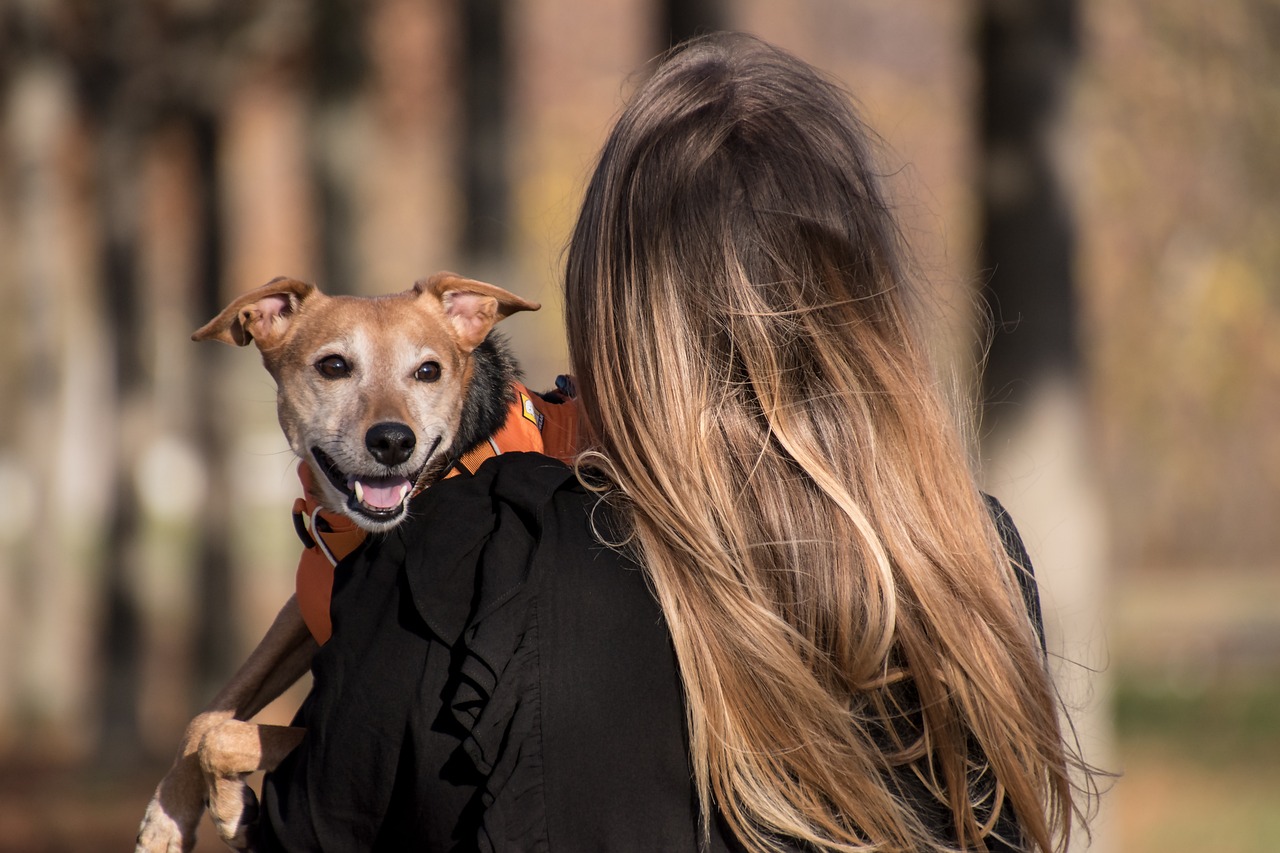
Activities for Pets During the Trip
When it comes to traveling with pets, keeping them engaged and entertained is just as important as ensuring their safety and comfort. After all, a happy pet makes for a happy journey! Imagine your furry friend wagging their tail in excitement as they discover new sights and smells along the way. To make the most of your adventure, consider incorporating a variety of activities that cater to your pet's needs and interests.
One of the best ways to keep your pets active and social is by exploring local parks. These green spaces offer a fantastic opportunity for your pets to stretch their legs, sniff around, and even make new furry friends. Before you set out, do a little research on nearby parks that allow pets. Look for parks with designated dog areas, walking trails, and plenty of shade to keep your pets comfortable. You might even find some parks that host special pet events or activities, so keep an eye out for those!
In addition to parks, many destinations boast a variety of pet-friendly attractions. Imagine sipping a coffee at a cozy café while your pup lounges at your feet, or enjoying a meal at a restaurant that welcomes your furry companion. Pet-friendly beaches are another fantastic option, where your pet can frolic in the sand and splash in the waves. To help you plan, here’s a quick table of popular pet-friendly activities you might find:
| Activity | Description | Location Examples |
|---|---|---|
| Local Parks | Open spaces for walking, playing, and socializing. | Central Park, Golden Gate Park |
| Pet-Friendly Beaches | Beaches where pets can roam freely and enjoy the water. | Dog Beach, Carmel Beach |
| Outdoor Cafés | Cafés with outdoor seating that welcome pets. | Starbucks, local coffee shops |
| Pet Events | Special events like pet parades or festivals. | Local fairs, community events |
Don't forget to pack some toys or interactive games that can keep your pets engaged during downtime. Whether it’s a favorite ball, a chew toy, or even a puzzle feeder, having something familiar can help ease any travel anxiety and keep them entertained. Just like us, pets enjoy a little stimulation to break the monotony of travel.
Lastly, remember that each pet is unique, and their preferences may vary. Pay attention to their cues and adjust your activities accordingly. If your dog loves to fetch, find a spot where you can throw a frisbee or ball. If your cat enjoys exploring, consider bringing a leash and harness for some outdoor adventures. The key is to create a balanced itinerary that includes plenty of opportunities for play and relaxation, ensuring that both you and your pet have a memorable trip together.
Q: What should I do if my pet is anxious during travel?
A: If your pet shows signs of anxiety, consider using calming products like pheromone sprays or consult your veterinarian for advice on anxiety medication. Regular breaks and familiar toys can also help ease their stress.
Q: Are there any specific breeds that are better suited for travel?
A: While any pet can travel, smaller breeds or those with calmer temperaments may adapt better to the travel experience. However, every pet is different, so it’s essential to consider their individual personality and comfort level.
Q: How can I find pet-friendly accommodations?
A: Websites like BringFido, Airbnb, and local tourism boards often list pet-friendly options. Always check the specific pet policies before booking to avoid any surprises!
Exploring Local Parks
When traveling with pets, one of the most delightful activities you can engage in is exploring local parks. These green spaces are often a treasure trove of adventure for your furry friends, offering them the chance to run, play, and socialize. Imagine your dog bounding through the grass, tail wagging, as they chase after a frisbee or make new friends. It’s not just exercise; it’s a full-blown party for them!
Before you pack up your gear and hit the park, though, it’s wise to do a little research. Not all parks are created equal when it comes to pet-friendliness. Some parks have specific areas designated for dogs, while others may have restrictions on leash laws or breed types. To make the most of your park experience, consider the following:
- Check Park Rules: Always verify the park's regulations regarding pets. Some parks require dogs to be on a leash at all times, while others may offer off-leash areas where your pet can roam free.
- Look for Amenities: Parks with pet-friendly amenities, like dog water fountains, waste stations, and agility courses, can enhance your visit. These features not only make the experience more enjoyable but also ensure you have everything you need to keep your pet happy.
- Plan for Socialization: If your pet enjoys the company of other animals, look for parks known for their pet-friendly atmosphere. Visiting during peak hours can increase the chances of your pet meeting new friends.
Another great aspect of visiting local parks is the opportunity to immerse yourself in the beauty of nature. Walking trails, scenic views, and picnic spots can make for a perfect day out. Don’t forget to bring along some essentials like water, snacks, and a portable pet bowl to keep your furry companion hydrated and energized. After all, a happy pet means a happy owner!
In addition to the natural beauty, many parks host events that welcome pets. From dog-friendly festivals to outdoor movie nights, these gatherings can provide a fantastic way to bond with your pet and other pet owners in the community. So, before you head out, check local listings to see what’s happening in the parks around you.
In summary, exploring local parks is not just a way to give your pet some exercise; it’s an opportunity to create cherished memories together. With a bit of planning and an adventurous spirit, you can turn a simple park visit into a day full of joy and excitement for both you and your furry friend.
Q: How do I find pet-friendly parks in a new area?
A: You can use various apps and websites dedicated to pet-friendly locations, or simply search online for "pet-friendly parks near me." Local pet shops or veterinarians might also have recommendations.
Q: Are there any specific rules I should know about before visiting a park with my pet?
A: Yes! Always check the park's rules regarding leashes, waste disposal, and any breed restrictions. It’s important to respect these regulations for the safety of all park visitors.
Q: What should I bring when visiting a park with my pet?
A: Essentials include water, a portable bowl, waste bags, snacks, and any toys your pet enjoys. If your pet is prone to overheating, consider bringing a cooling mat or towel.
Q: Can I let my pet off-leash in parks?
A: Only if the park has designated off-leash areas and your pet is well-trained. Always prioritize safety and supervision to ensure a positive experience for your pet and others.
Pet-Friendly Attractions
When it comes to traveling with your furry friends, finding can significantly enhance your experience. Imagine strolling down a vibrant boardwalk, the sun shining, and your dog happily trotting beside you. It’s not just about the destination; it’s about making memories with your pets. Many places now cater to our four-legged companions, so let’s dive into some exciting options that will keep your pets entertained and engaged.
First off, you might want to explore pet-friendly parks. These parks often feature designated areas where your pets can run off-leash, socialize with other dogs, and enjoy the great outdoors. Some parks even have agility courses and water features. Before you go, check out local listings or apps that highlight parks in your travel area. For example, a quick search could lead you to a hidden gem like a local dog park with a splash pad. What could be more refreshing on a hot day?
Another fun option is visiting pet-friendly beaches. Many coastal areas allow pets, providing a perfect backdrop for a day of sun and surf. Imagine your dog bounding through the waves, chasing after a frisbee, while you relax on the sand. Just remember to bring fresh water and a shady spot for your pet to cool off. Some beaches may have specific hours for pets, so check their rules to avoid any surprises.
Restaurants are also getting in on the pet-friendly trend. More and more eateries are welcoming pets on their patios, allowing you to enjoy a meal while your pet lounges by your side. Look for places that offer dog menus or treats to make your pet feel special. It’s a win-win: you get to enjoy a nice meal, and your pet gets to enjoy a tasty snack. Plus, dining al fresco can be a delightful experience, especially in good weather.
Events are another fantastic way to include your pets in your travels. From pet parades to dog-friendly festivals, there’s often something happening in towns across the country. These events not only provide entertainment but also give your pets a chance to socialize with other animals. Keep an eye on local calendars or social media groups to find out about upcoming events during your visit.
Lastly, don't forget about pet-friendly accommodations that often have their own attractions or partnerships with local businesses. Some hotels offer pet amenities like doggy daycare, grooming services, or even pet-sitting. This can give you peace of mind and allow you to explore the area without worrying about your pet being bored or anxious.
In summary, traveling with pets opens up a world of possibilities for fun and adventure. By seeking out pet-friendly attractions, you can create a travel experience that is enjoyable for both you and your furry companions. Whether it’s exploring a new park, lounging on the beach, or dining at a local café, the memories you make together will be priceless.
Q: Are all beaches pet-friendly?
A: No, not all beaches allow pets. It’s essential to check local regulations before heading out to ensure your furry friend is welcome.
Q: What should I pack for my pet when traveling?
A: Be sure to bring essentials like food, water, bowls, leashes, waste bags, and any medications your pet may need. A favorite toy or blanket can also help your pet feel more comfortable in new environments.
Q: Can I take my pet to restaurants?
A: Many restaurants with outdoor seating allow pets, but it’s always best to call ahead and confirm their pet policy.
Q: How can I find pet-friendly parks?
A: You can use apps or websites dedicated to pet-friendly locations, or simply search online for local parks that allow pets.
Frequently Asked Questions
- What should I consider when planning a group trip with pets?
When planning a group trip with pets, consider accommodations that are pet-friendly, transportation options that ensure comfort, and destinations that cater to pets. It’s essential to coordinate with all pet owners in the group to meet everyone's needs and preferences.
- How can I find pet-friendly accommodations?
To find pet-friendly accommodations, research hotels, vacation rentals, or campsites that explicitly welcome pets. Websites like Airbnb or Booking.com often have filters for pet-friendly options. Always read the fine print regarding their pet policies to avoid surprises.
- What are common pet policies I should be aware of?
Common pet policies include restrictions on the size or breed of pets, additional fees for bringing pets, and requirements for leashing or crating pets in common areas. Make sure to familiarize yourself with these policies to ensure a smooth stay.
- How can I ensure my pet's safety during travel?
To ensure your pet's safety during travel, use proper restraints like harnesses or crates, take frequent breaks for stretching and hydration, and never leave your pet unattended in a vehicle. Prioritizing your pet's comfort and safety will make the journey more enjoyable for everyone.
- What activities can I do with my pets during the trip?
Engage your pets in activities like visiting local parks for exercise and socialization, exploring pet-friendly attractions such as restaurants or beaches, and participating in events that welcome pets. This keeps them entertained and helps create lasting memories.
- Are there any specific transportation options better suited for traveling with pets?
Cars are often the most convenient option for traveling with pets, as they allow for flexibility in breaks and comfort. However, if traveling by bus or plane, check the respective pet policies and ensure that your pet is comfortable and safe during the journey.

